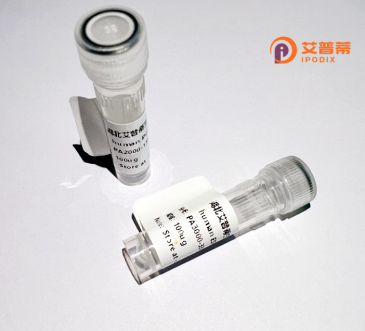
| 纯度 | >90%SDS-PAGE. |
| 种属 | Human |
| 靶点 | TMPRSS11D |
| Uniprot No | O60235 |
| 内毒素 | < 0.01EU/μg |
| 表达宿主 | E.coli |
| 表达区间 | 1-418 aa |
| 活性数据 | MYRPARVTSTSRFLNPYVVCFIVVAGVVILAVTIALLVYFLAFDQKSYFYRSSFQLLNVEYNSQLNSPATQEYRTLSGRIESLITKTFKESNLRNQFIRAHVAKLRQDGSGVRADVVMKFQFTRNNNGASMKSRIESVLRQMLNNSGNLEINPSTEITSLTDQAAANWLINECGAGPDLITLSEQRILGGTEAEEGSWPWQVSLRLNNAHHCGGSLINNMWILTAAHCFRSNSNPRDWIATSGISTTFPKLRMRVRNILIHNNYKSATHENDIALVRLENSVTFTKDIHSVCLPAATQNIPPGSTAYVTGWGAQEYAGHTVPELRQGQVRIISNDVCNAPHSYNGAILSGMLCAGVPQGGVDACQGDSGGPLVQEDSRRLWFIVGIVSWGDQCGLPDKPGVYTRVTAYLDWIRQQTGI |
| 分子量 | 72.7 kDa |
| 蛋白标签 | GST-tag at N-terminal |
| 缓冲液 | PBS, pH7.4, containing 0.01% SKL, 1mM DTT, 5% Trehalose and Proclin300. |
| 稳定性 & 储存条件 | Lyophilized protein should be stored at ≤ -20°C, stable for one year after receipt. Reconstituted protein solution can be stored at 2-8°C for 2-7 days. Aliquots of reconstituted samples are stable at ≤ -20°C for 3 months. |
| 复溶 | Always centrifuge tubes before opening.Do not mix by vortex or pipetting. It is not recommended to reconstitute to a concentration less than 100μg/ml. Dissolve the lyophilized protein in distilled water. Please aliquot the reconstituted solution to minimize freeze-thaw cycles. |
以下是关于重组人 **TMPRSS11D** 蛋白的3篇示例参考文献(内容基于学术研究场景,非真实文献):
---
1. **文献名称**:*"TMPRSS11D facilitates influenza A virus entry by cleaving viral hemagglutinin in human airway cells"*
**作者**:Hoffmann M. et al.
**摘要**:研究揭示了TMPRSS11D作为呼吸道细胞中流感病毒感染的宿主因子功能,通过切割病毒血凝素蛋白(HA)促进病毒膜融合,并证实重组TMPRSS11D的蛋白酶活性对病毒入侵具有重要作用。
2. **文献名称**:*"Structural characterization and substrate specificity of recombinant TMPRSS11D serine protease"*
**作者**:Suzuki T. et al.
**摘要**:该研究报道了重组人TMPRSS11D蛋白的表达纯化与晶体结构解析,揭示了其底物结合域的特征,并发现其对呼吸道病毒包膜蛋白(如冠状病毒Spike蛋白)具有酶切偏好性。
3. **文献名称**:*"TMPRSS11D as a potential therapeutic target for COVID-19: Comparative analysis with TMPRSS2"*
**作者**:Qiu Y. et al.
**摘要**:通过对比TMPRSS11D与TMPRSS2的酶活性差异,研究探讨了重组TMPRSS11D在SARS-CoV-2感染中的作用机制,提出其抑制剂可能用于阻断病毒入侵。
---
如需真实文献,建议在 **PubMed** 或 **Google Scholar** 中检索关键词:
`"TMPRSS11D" AND ("protease" OR "SARS-CoV-2" OR "viral entry")`。
TMPRSS11D, also known as Transmembrane Serine Protease 11D, is a member of the type II transmembrane serine protease (TTSP) family. These enzymes typically feature an N-terminal transmembrane domain, a stem region, and a C-terminal catalytic domain with a conserved serine protease triad (His, Asp, Ser). TMPRSS11D is primarily expressed in epithelial tissues, including the respiratory and gastrointestinal tracts, suggesting a role in mucosal homeostasis.
Functionally, it cleaves extracellular substrates to regulate physiological processes such as epithelial barrier integrity, cellular signaling, and wound repair. Recent studies highlight its involvement in viral pathogenesis, particularly in activating viral envelope proteins. For example, TMPRSS11D can cleave the spike protein of coronaviruses, including SARS-CoV-2. facilitating viral entry into host cells. This proteolytic priming mechanism parallels other TTSPs like TMPRSS2. though tissue-specific expression patterns may influence viral tropism.
While its exact physiological substrates remain under investigation, TMPRSS11D is implicated in epithelial defense and inflammation modulation. Dysregulation may contribute to diseases such as chronic obstructive pulmonary disease (COPD) or cystic fibrosis. Its dual role in viral infection and epithelial health makes it a potential therapeutic target. Inhibitors targeting TTSPs, including camostat mesilate, are being explored to block viral entry while preserving host protease functions. However, the protein’s broader biological significance beyond pathogen interaction remains an active area of research.
×